|
Paul M. VELEZ
| ||||||||||||||||||||||||||||||||||||||||||||||||||||||||||||||||||||||||||||||||
|---|---|---|---|---|---|---|---|---|---|---|---|---|---|---|---|---|---|---|---|---|---|---|---|---|---|---|---|---|---|---|---|---|---|---|---|---|---|---|---|---|---|---|---|---|---|---|---|---|---|---|---|---|---|---|---|---|---|---|---|---|---|---|---|---|---|---|---|---|---|---|---|---|---|---|---|---|---|---|---|---|
 | ||||||||||||||||||||||||||||||||||||||||||||||||||||||||||||||||||||||||||||||||
| NUMERO DE SERVICE | 32190683 | |||||||||||||||||||||||||||||||||||||||||||||||||||||||||||||||||||||||||||||||
| AGE | 31 ans | |||||||||||||||||||||||||||||||||||||||||||||||||||||||||||||||||||||||||||||||
| DATE DE NAISSANCE | 1913 PORTO RICO | |||||||||||||||||||||||||||||||||||||||||||||||||||||||||||||||||||||||||||||||
| ETAT | NEW YORK | |||||||||||||||||||||||||||||||||||||||||||||||||||||||||||||||||||||||||||||||
| FAMILLE | Single | |||||||||||||||||||||||||||||||||||||||||||||||||||||||||||||||||||||||||||||||
| GRADE | PFC | |||||||||||||||||||||||||||||||||||||||||||||||||||||||||||||||||||||||||||||||
| FONCTION | Infantry | |||||||||||||||||||||||||||||||||||||||||||||||||||||||||||||||||||||||||||||||
| PROFESSION AVANT INCORPORATION | Photographe |  | ||||||||||||||||||||||||||||||||||||||||||||||||||||||||||||||||||||||||||||||
| DATE D'INCORPORATION | 12 novembre 1941 Camp Upton Yaphank NEW YORK | |||||||||||||||||||||||||||||||||||||||||||||||||||||||||||||||||||||||||||||||
| REGIMENT | 12nd Infantry Regiment | |||||||||||||||||||||||||||||||||||||||||||||||||||||||||||||||||||||||||||||||
| DIVISION | 4thInfantry Division " Ivy Division" | |||||||||||||||||||||||||||||||||||||||||||||||||||||||||||||||||||||||||||||||
| DATE DU DECES | 9 juin 1944 |  | ||||||||||||||||||||||||||||||||||||||||||||||||||||||||||||||||||||||||||||||
| STATUT | KIA | |||||||||||||||||||||||||||||||||||||||||||||||||||||||||||||||||||||||||||||||
| LIEU DU DECES | Azeville (Manche) | |||||||||||||||||||||||||||||||||||||||||||||||||||||||||||||||||||||||||||||||
| CIMETIERE | NORMANDY AMERICAN CEMETERY de Colleville | |||||||||||||||||||||||||||||||||||||||||||||||||||||||||||||||||||||||||||||||
| TOMBE |
| |||||||||||||||||||||||||||||||||||||||||||||||||||||||||||||||||||||||||||||||
| DECORATION |
| |||||||||||||||||||||||||||||||||||||||||||||||||||||||||||||||||||||||||||||||
| ||||||||||||||||||||||||||||||||||||||||||||||||||||||||||||||||||||||||||||||||
| HISTOIRE | ||||||||||||||||||||||||||||||||||||||||||||||||||||||||||||||||||||||||||||||||
| -- | ||||||||||||||||||||||||||||||||||||||||||||||||||||||||||||||||||||||||||||||||
Activated/Activé |
Normandy/Normandie |
| 1 Jun 1940 | Days of Combat/Jour de Combat 299 |
| Casualties/Victimes 22 660 | |
Entered Combat/Entré au combat |
|
| 6 Jun 44 D-Day | |
|
Commanding Generals/Commandants généraux Maj. Gen. Walter E. Prosser (Jun 40 - Oct 40) |
Campaigns/CampagnesNormandy (6 Jun 44 - 24 Jul 44)
|
PLAN DE ROUTE DE LA CAMPAGNE - CAMPAIGN ROUTE MAP |
|
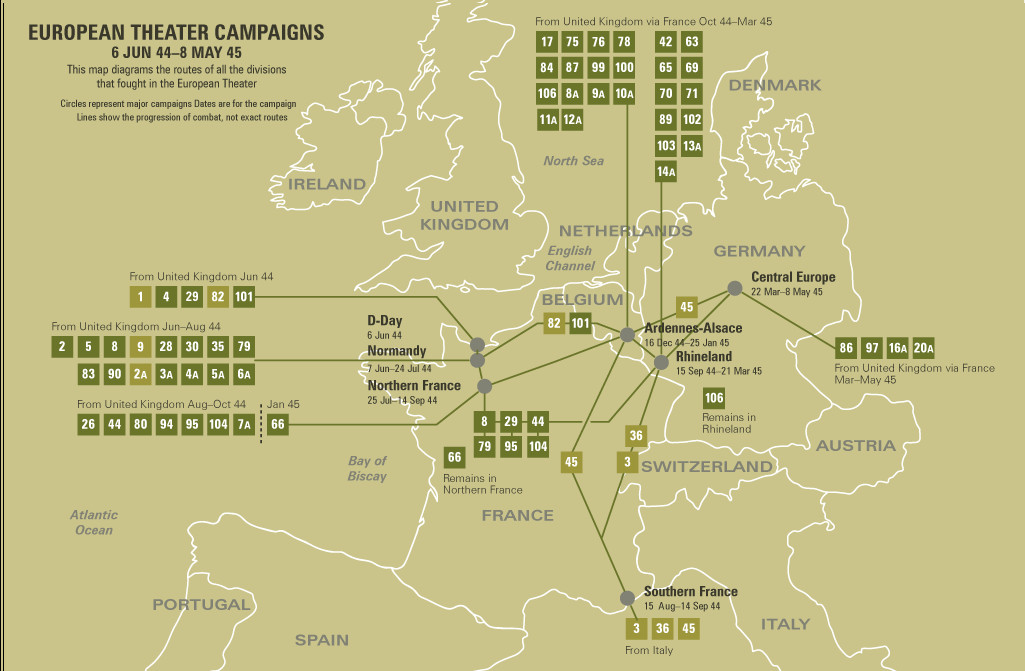 |
|
DIVISION CHRONICLEThe 8th Infantry Regiment of the 4th Division was one of the first Allied units to hit the beaches at Normandy on D-day, 6 June 1944. Relieving the isolated 82nd Airborne Division at Ste. Mere Eglise, the 4th cleared the Cotentin peninsula and took part in the capture of Cherbourg, 25 June. After taking part in the fighting near Periers, 6-12 July,, the Division broke through the left flank of the German Seventh Army, helped stem the German drive toward Avranches, and by the end of August had moved to Paris, assisting the French in the liberation of their capital. The 4th then moved into Belgium through Houffalize to attack the Siegfried Line at Schnee Eifel, 14 September, and made several penetrations. Slow progress into Germany continued in October, and by 6 November the Division reached the Hurtgen Forest, where a severe engagement took place until early December. It then shifted to Luxembourg, only to meet the German winter offensive head-on, 16 December 1944. Although its lines were dented, it managed to hold the Germans at Dickweiler and Osweiler, and, counterattacking in January across the Sauer, overran German positions in Fouhren and Vianden. Halted at the Prum in February by heavy enemy resistance, the Division finally crossed 28 February near Olzheim, and raced on across the Kyll, 7 March. After a short rest, the 4th moved across the Rhine 29 March at Worms, attacked and secured Wurzburg and by 3 April had established a bridgehead across the Main at Ochsenfurt. Speeding southeast across Bavaria, the Division had reached Miesbach on the Isar, 2 May 1945, when it was relieved and placed on occupation duty. |
CHRONIQUE DE DIVISIONLe 8e régiment d'infanterie de la 4e division fut l'une des premières unités alliées à débarquer sur les plages de Normandie le 6 juin 1944, jour du débarquement. Soulager la 82nd Airborne Division isolée de Ste. Mère Eglise, le 4e défricha la presqu'île du Cotentin et participa à la prise de Cherbourg le 25 juin. Après avoir pris part aux combats près de Periers, du 6 au 12 juillet, la Division a franchi le flanc gauche de la Septième armée allemande, aidé à endiguer la route allemande vers Avranches et, à la fin du mois d'août, s'est installée à Paris, aidant les Français. dans la libération de leur capitale. Le 4e s'est ensuite déplacé en Belgique par Houffalize pour attaquer la ligne Siegfried à Schnee Eifel, le 14 septembre, et a fait plusieurs pénétrations. Les progrès lents en Allemagne se sont poursuivis en octobre et, le 6 novembre, la division a atteint la forêt de Hurtgen, où un engagement sévère a eu lieu jusqu'au début du mois de décembre. Il s'est ensuite déplacé vers le Luxembourg, seulement pour affronter l'offensive allemande d'hiver, le 16 décembre 1944. Bien que ses lignes aient été bosselées, il a réussi à tenir les Allemands à Dickweiler et Osweiler et, contre-attaquant en janvier à travers la Sauer à Fouhren et Vianden. Arrêtée au Prum en février par une forte résistance ennemie, la Division a finalement franchi le 28 février près d'Olzheim et a couru à travers le Kyll, le 7 mars. Après un court repos, le 4 mars traversa le Rhin à Worms, attaqua et sécurisa Wurzburg le 29 mars et, le 3 avril, il établit une tête de pont sur le Main à Ochsenfurt. Accélérant le sud-est à travers la Bavière, la division avait atteint Miesbach sur l'Isar, le 2 mai 1945, quand elle fut relevée et placée en devoir d'occupation. |
| SOURCE INFORMATION & PHOTO | Armydivs.squarespace.com |
|---|
| |||||||||||||||||||||||||||||||||||||||||||||||||||||||||||||||||||||||||||||
|---|---|---|---|---|---|---|---|---|---|---|---|---|---|---|---|---|---|---|---|---|---|---|---|---|---|---|---|---|---|---|---|---|---|---|---|---|---|---|---|---|---|---|---|---|---|---|---|---|---|---|---|---|---|---|---|---|---|---|---|---|---|---|---|---|---|---|---|---|---|---|---|---|---|---|---|---|---|
| SOURCE INFORMATION & PHOTO | Aad.archives.gov - Cyrille MARIE - Clive TIRLEMONT - Jean-Yves TURQUETIL Livre: 21st Army Group (HEIMDAL) - U.S Army Center of Military History Utah Beach to Cherbourg - American D.DAY.org Les Américains en Normandie . Eric Rondeau - La trouée de Normandie. Albert Pipet DDay Overlord - Breakout and Pursuit. Martin Blumenson - Genealogycenter.info |
|---|---|
| PROGRAMMEURS | Clive, Frédéric & Renaud |





















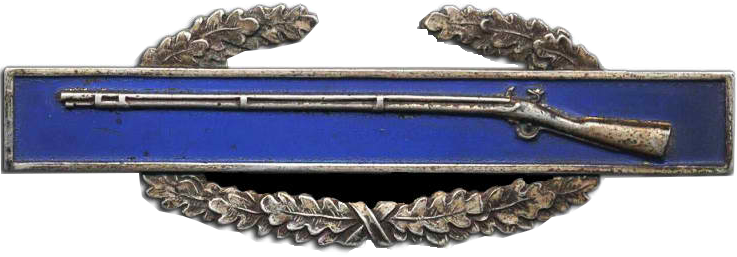

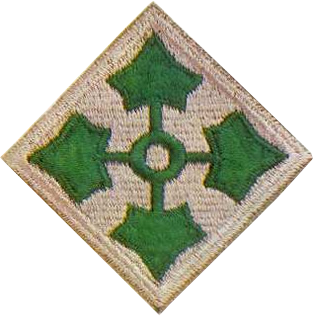
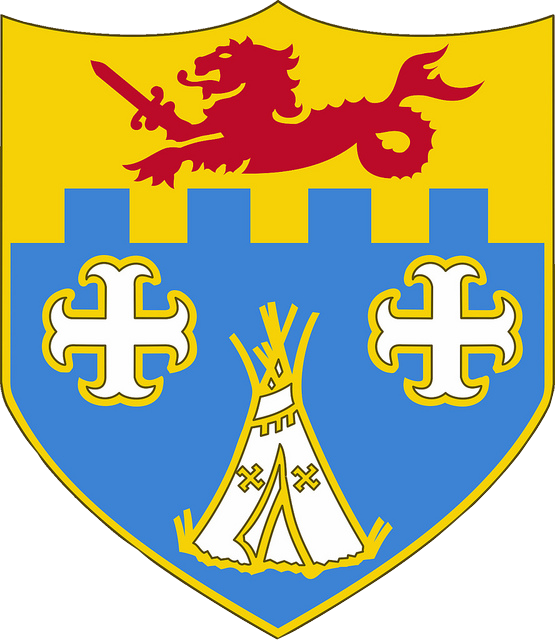




 VII Corps
VII Corps



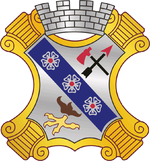 8th Infantry Regiment
8th Infantry Regiment 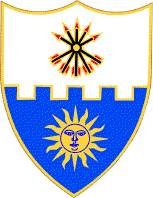 22th Infantry regiment
22th Infantry regiment 







